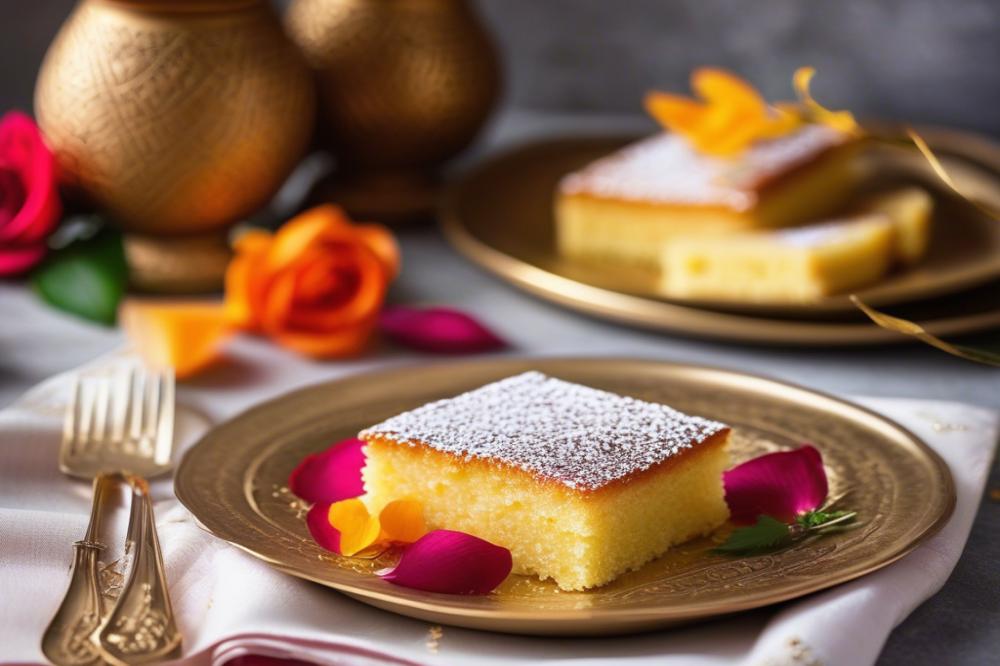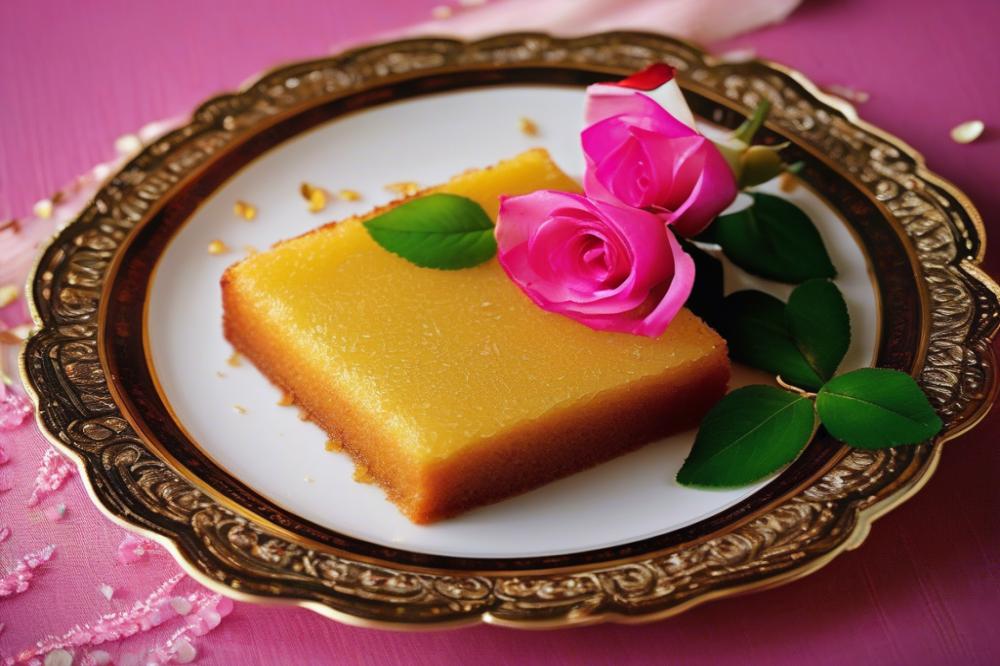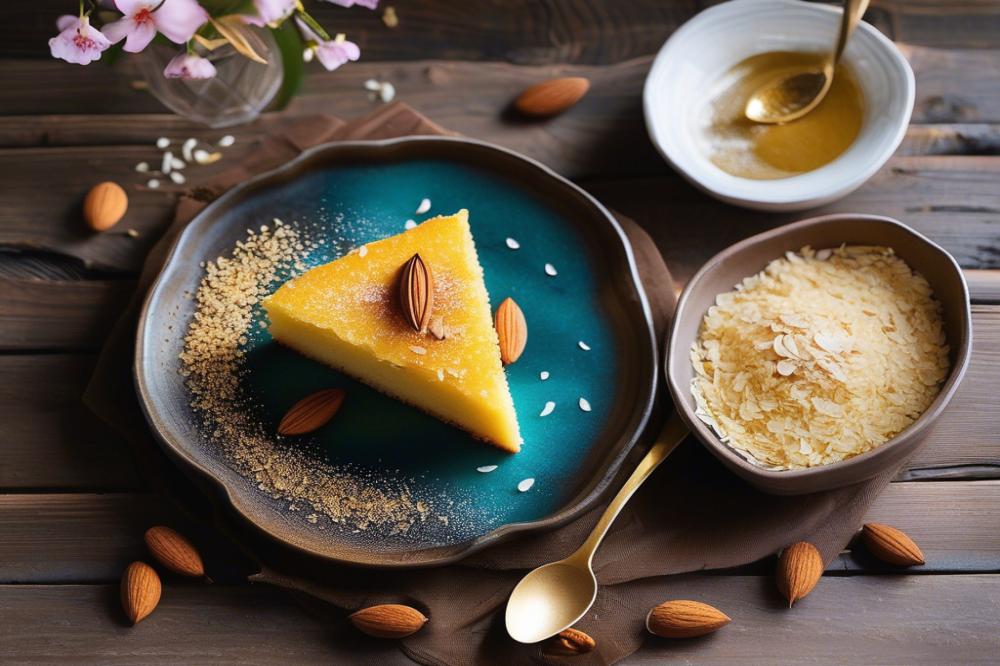Discovering Basbousa: A Sweet Tradition
Basbousa is a classic Egyptian dessert beloved across the Middle East. This Semolina Cake is celebrated for its moist texture and sweet syrup. traditional dessert lovers appreciate its rich flavor and ease of preparation. Many families include it in their festive treats, making it a staple during celebrations.
You’ll often find this cake at gatherings and special occasions. Whether it’s Ramadan, weddings, or family reunions, basbousa is a highlight on dessert tables. Its popularity as a Middle Eastern sweet reflects the cultural cuisine of the region.
For those looking for easy recipes, this Semolina Cake recipe is perfect. Baking tips for creating the perfect basbousa are simple to follow. Coconut basbousa adds a unique twist, offering delightful flavors for those who prefer a tropical touch. Making this dish is a joyful experience, as sharing it with others amplifies its sweetness.
Embrace these dessert ideas and enjoy preparing a treat that carries so much history and love. Making basbousa allows you to connect with cultural traditions while delighting friends and family with a delicious creation.
Understanding Basbousa

This traditional dessert has roots in the Middle Eastern culinary landscape. Originating from Egyptian cuisine, it has spread across the region, finding a beloved spot in many homes. Often served during special occasions, this semolina cake is more than just a treat; it’s a symbol of hospitality and celebration. The dessert is popular during festive treats and family gatherings, showcasing its strong cultural ties.
Key characteristics define the dessert. Its texture is moist and dense, yet light, making each bite a delightful experience. The cake is sweet, often enhanced with a fragrant syrup made from sugar and water, sometimes flavored with rose water or orange blossom. Meanwhile, the flavor profile is subtly nutty, thanks to the semolina, which is the main ingredient. This balance between sweetness and subtlety makes it a favorite among many.
Many variations exist to excite the palate. Coconut basbousa is one popular twist, often incorporating shredded coconut into the batter. This addition results in a chewiness that pairs well with the softness of the cake. Additionally, regional differences in preparation can be seen. In some areas, the cake may include nuts or fruits, giving each version its signature touch.
When exploring easy recipes, you might find some calling for yogurt or buttermilk, enhancing the cake’s moisture. There are also baking tips to consider, such as letting the syrup soak into the cake while it’s still warm. This technique maximizes flavor and moisture, ensuring a satisfying dessert experience. With so many dessert ideas available, everyone can find a way to enjoy this cultural cuisine.
Ingredients and Method

To make this traditional dessert, gather the following ingredients. A well-stocked kitchen will typically provide most of these items. Preparing this Middle Eastern sweet is straightforward and requires basic components.
Ingredients List:
- 1 cup fine semolina
- 1 cup plain yogurt
- 1 cup granulated sugar
- 1/2 cup melted butter or oil
- 1 teaspoon baking powder
- 1/2 cup unsweetened shredded coconut (optional for coconut basbousa)
- Almonds (for garnish)
Cooking Instructions:
Start by preheating the oven to 350°F (175°C). This step is essential for even baking.
In a mixing bowl, combine semolina, yogurt, melted butter, sugar, baking powder, and the shredded coconut if you are using it. A thorough mix will yield a smooth batter.
Next, pour the batter into a greased baking dish. Don’t forget to smooth the top for an even bake.
Score the surface into diamond or square shapes. Place an almond in the center of each carved piece for a decorative touch.
Then, bake for 30-35 minutes. Keep an eye on it until the surface turns golden brown.
While the cake bakes, prepare a sweet syrup. Combine equal parts sugar and water, boiling 1 cup of each for 10 minutes. Add a splash of lemon juice, along with a dash of rose or orange blossom water if desired.
When the cake comes out of the oven, pour the cooled sweet syrup over the hot cake. This step is crucial for flavor infusion.
Allow the cake to absorb the syrup and cool before slicing and serving. It’s a delightful treat, perfect for festive occasions.
Nutritional Information:
The semolina cake recipe offers a variety of nutritional benefits. It is rich in carbohydrates, which provide energy. Yogurt adds a dose of healthy fats and protein. Granulated sugar, while sweet, contributes calories. Coconut, when included, offers fiber and adds texture. Each almond provides healthy fats and nutrients. These aspects combine to create a balanced dessert idea in the realm of cultural cuisine.
Baking Tips for Perfect Basbousa

Getting the right texture is crucial when making this traditional dessert. Start with a good quality semolina. A fine texture will produce a smoother cake. If you use coarse semolina, the cake might turn out grainy. Mixing it with yogurt adds moisture, creating that deliciously tender crumb.
Watch your baking time closely. The oven’s temperature can vary, so check for doneness a few minutes early. When the edge begins to brown, it’s a good sign. Overbaking can lead to dry results, while underbaking may leave the center too wet.
Moisture plays a key role in creating a delightful flavor. Pouring sweet syrup over the cake while it’s still warm traps moisture inside. However, cooling the syrup is essential before applying it. Hot syrup on a hot cake may lead to a soggy texture instead of the desired soaking effect.
Consider adding shredded coconut for a twist. Coconut basbousa enhances the flavor and offers a unique texture. Experimenting with different flavorings, like vanilla or almond extract, can also elevate your cake.
Learning from common pitfalls can save you disappointment. Sometimes the cake rises beautifully but collapses after cooling. This often means the batter was overmixed. Gently fold in ingredients to maintain airiness.
These baking tips serve as a guide for anyone trying their hand at this Middle Eastern sweet. Remember that practice makes perfect. There are endless dessert ideas in cultural cuisine, each needing a little attention to detail. With these techniques, your semolina cake recipe will impress.
Serving Suggestions and Variations

This traditional dessert offers many ways to enjoy it. Some love to savor it on its own, paired with a hot cup of coffee or fragrant tea. The sweetness of the cake complements a strong beverage perfectly, creating a delightful experience.
Consider arranging pieces on a larger dessert platter. This can include various Middle Eastern sweets, such as baklava and maamoul. Guests will appreciate the diverse flavors and textures. It makes a festive treat that can brighten any gathering.
For those looking to get creative, variations on the basic semolina cake recipe can be simple and fun. Adding nuts—like almonds, pistachios, or walnuts—can enhance both the flavor and presentation. A coconut basbousa version introduces a tropical flair. This twist can attract even those who think they don’t like semolina.
Flavored syrups can elevate the taste. Try infusing your syrup with rosewater or orange blossom. Such additions give an aromatic touch, making the cake even more appealing. Drizzling this sweet syrup on top creates a beautiful glaze that glistens in the light.
Another fun idea involves pairing slices of this delectable cake with a scoop of ice cream. The contrast between warm cake and cold ice cream is truly delightful. Vanilla or pistachio flavors work wonderfully, creating a modern dessert experience.
During festive seasons, consider incorporating this cake into your celebrations. Serving it at gatherings or holiday meals can be a wonderful way to share cultural cuisine with family and friends. Many find that baking tips are essential for creating a moist and fluffy texture.
Overall, this easy recipe is versatile and can adapt to various occasions. The possibilities for dessert ideas are endless. Whether served plainly or with unique twists, nothing compares to enjoying a piece of this beloved cake during a joyful moment.
Cultural Significance of Basbousa
In Egypt and throughout the Middle East, Basbousa holds a special place in the hearts of many. This traditional dessert often graces the tables during festive occasions and family gatherings. Celebrations such as weddings, holidays, and religious events frequently feature this beloved semolina cake. Significant moments become even more memorable when shared over a slice of this sweet delight.
Sweet syrup drizzled on top enhances its flavor, making it a favorite among various Middle Eastern sweets. Many families boast their own version of the semolina cake recipe, often incorporating personal touches or secret ingredients. That’s part of its charm. Generations pass down these easy recipes, ensuring that each new cook has a taste of their heritage in every bite.
Fond memories arise when people reminisce about baking sessions with loved ones. For some, preparing a coconut basbousa brings back childhood moments spent in their grandmother’s kitchen, surrounded by laughter and the aroma of baking. These experiences connect individuals to their roots and the cultural cuisine of their ancestors.
When hosting guests, serving this dessert idea often becomes a way to showcase hospitality. It’s a common sight to see Basbousa offered alongside coffee or tea, inviting good conversation and laughter. Different variations reflect the diverse backgrounds within Middle Eastern culture, allowing for shared experiences through food.
Baking tips from family members also play a role in creating that perfect texture and flavor. Whether it’s a rich, dense version or a lighter take, creativity shines through. Each bite becomes a journey through time, connecting people to traditions, memories, and a sense of belonging.
Final Thoughts on Making Basbousa
Creating this delicious dessert is an enjoyable experience that can brighten any day. The process of blending ingredients, pouring the batter, and watching it rise in the oven brings a sense of satisfaction. More than just a treat, this traditional dessert carries roots in many cultures, particularly in Middle Eastern sweets. People from various backgrounds cherish this semolina cake for its delightful texture and sweet syrup.
Whether celebrating a special occasion or simply wanting a tasty snack, this dish brings people together. Family and friends can gather around a table, sharing slices and laughter. Encouraging creativity while cooking allows individuals to add personal touches. Some may choose to sprinkle nuts on top or experiment with flavored syrups, varying the outcome in exciting ways.
If you’ve made it before, consider sharing your experiences or unique variations with others. For those new to this recipe, now is the perfect time to embrace an enjoyable culinary journey. Remember, the joy of making this cake is just as significant as relishing every bite. So gather your ingredients and give it a try!



